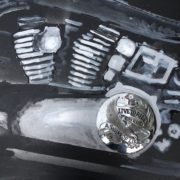1966, Hello
Monkey Boy
Not every monkey has an uncle, and I can’t see Darwin or his detractors, either one, laboring to contest that fact. But each of us, from the free thinkers down, has a family. And every family has its fair share of secrets. And while money and stature can buy your family some time in terms of allowing certain secrets to remain hidden, eventually the truth always comes out. And just as the glamour and power of the Kennedys couldn’t conceal or be diminished by the factually-based myth of a defective cousin warehoused somewhere deep in the bowels of Hyannis Port, neither can the years of denial and obfuscation by members of my own family manage to obscure my memory of what I know that I saw one summer’s day in my youth at Pine Lake.
I don’t pander to mythos. Anybody with half of an imagination can testify to that. And even though my personal reality might be skewed by my unique perceptions, the fact is, I deal in hard realities. One hard reality that I’ve been dealing with is the fact that I’ve been trying to write this story for over forty years, but never had an ending until now. Another hard reality is that Pine Lake is really just a pond. And it isn’t even a very large pond.
Pine Lake is actually a small pond in an abandoned corn-field surrounded by red-clay mud. About a hundred and fifty yards up the hill from this optimistically-named natural body of water is an old in-ground concrete swimming-pool, a remnant of a long-gone motel deemed irrelevant by the bypass. But bypass or no, Pine Lake was the uncontested summertime mecca to several generations of western Pittsylvania County’s finest.
One summer Saturday afternoon when I was six or seven in 1966, my family descended upon Pine Lake. My mother, her mother and father, my mother’s younger sisters, brothers, wives, husbands, in-laws, outlaws, my siblings, first and second cousins, third cousins, my dad, his dad, and I took over the destination in its entirety. Half of us attempted to splash all of the water out of the pool while my two uncles on my mother’s side backed up their truck and put their homemade motorboat into the lake down the hill.
My father was lighting a charcoal grill, grinning from ear to ear. As my mother double-coated my back with lotion, I heard my uncles down at the lake roar in approval as they successfully started up their motorboat. I broke free from my mother’s clutches and bounded down to the belching boat bobbing up and down in the red-brown water.
My teenaged uncles, Dallas and Charles, were looking quite pleased by the fruits of their efforts. They had been on a mission for over two years to construct a motorboat, put it in the water at Pine Lake, and water ski. The summer before they had rigged-up an oversized outboard motor to an old wooden canoe. That motor had also started right up. But Dallas and Charles hadn’t quite worked out the details of a functional rudder or a kill switch. So when they fired up the motor, the canoe shot straight across the lake with them in it, hit the bank at full-speed and cut a foot-deep groove in the red-clay beach that ran fifty yards down the hill to where the canoe finally came to its final resting place.
As nearly a quarter of the water in Pine Lake drained away downhill through the foot-deep ditch cut by the runaway boat, the engine then exploded. What was left of the canoe and gasoline had burned well into the evening. Uncles Dallas and Charles escaped with some burns and abrasions. Lessons learned. This time around, their boat had all of the amenities, including steering, a kill switch and a rudder.
“Who wants to be first?” Uncle Dallas threw out the tow line into the water.
I immediately leaped into Pine Lake. I ran out towards the tow-line that was visible in the water behind the boat. When the water got over my head I attempted to swim. I couldn’t swim. I reckon the water was about four feet deep and that was just a couple of inches deeper than I was. I was down in that murky water ham-paddling nowhere for what seemed like a week. Uncle Dallas finally pulled me up sputtering and shooting water out of my nose.
Dallas said “Here, you wild thing. Put these on.” Then he helped me put on a faded orange life-vest and a pair of skis. After some brief instructions the rudder was dropped, anchor hove, steering wheel buried hard-left and the slack was taken out of the towline.
Uncle Charles goosed the motor while Uncle Dallas simultaneously let go of me and I was up . . . skiing! And then I was down . . . underwater . . .
above the water . . . on the water . . . refusing to let go of the handle of the towline.
We circumnavigated Pine Lake exactly three times before I was beached. Still refusing to let go of the tow-line, I circumnavigated the bank of Pine Lake once more and then skittered off down the hill following a similar trajectory to that of the previous year’s ill-fated canoe, where I came to rest at the base of an elm tree and just lay there like I was dead for a while.
“Hey, kid. You’re an animal! Nice ride.” Dallas helped me to my feet and removed my life vest. “Get in line and you can have another ride later.”
There was a line of people, young and old, family, friend and strangers queued-up for a chance to water-ski in Pine Lake behind Dallas and Charles’ homemade motorboat. I just stood there for a while and watched the procession and listened. They had gleaned much from that initial ride that I’d taken. The water was about four-feet deep so they put out four and a half feet of rudder, and basically just let the boat spin around like a top in the middle of the lake.
The more experienced skiers were getting more like four times around the lake before getting beached. It looked like a long wait to get another chance to ski, so I started walking back around Pine Lake towards the uphill side. I was covered in red-clay mud and needed to rinse-off. I considered a dip in the lake but the motor-boat and skiers made that difficult. Plus, the lake’s water, naturally reddish brown, was taking-on a darker, oily hue. I decided to rinse off in the pool.
I scrambled up the hillside from the lake and jumped into the pool in the shallow end. As soon as I hit the water people started screaming!
“He’s filthy! Get him
out! Eeewww!”
A brown cloud spread-out from my body and filled the shallow end. I could smell and taste the lake water and local mud mixed with what was left of my sunscreen and various ointments as they dissolved into the pool water, which tasted better than it looked. The nasty comments from family and strangers continued.
“Get him out! Gross! Geez.”
It wasn’t as if the water in the pool was pristine before I got in. Then my mother jerked me up out of the pool by my arm and stood me up on the pool’s deck.
“Go over there to the shower and clean-off before you get back in this pool! You hear me?”
I hated to disappoint my Mama and started trudging around the deep end of the pool toward the shower, which was a garden-hose tied to the top of a two-by-four which was stuck in the clay. The sun came out from behind a cloud and its sudden brilliance blinded me. I had to avert my eyes, and looked down at the murky red water-cloud that I’d contributed to the shallow end as it reached the deep end, lending a clarifying background hue to the reflection in the water.
In the reflection I could clearly see him. He was standing on the concrete deck across the deep end of the pool from me. It was a monkey boy!
I was gob-smacked. Stunned. Time stood still. The monkey boy met my gaze as we both stared at his reflection on the water. He looked to be about my height and was covered from head-to-toe in a fine, reddish fur and wearing a special monkey diaper that allowed his little tail to breathe and wiggle around. I was mesmerized by his twitchy movements that seemed to mimic my thoughts.
“Comment allez-vous?”
The monkey boy spoke French! Although I didn’t recognize the words I could intuit the context. But before I could answer the monkey boy’s query, my mother had me by the elbow and was dragging me away. “Time to go home!”
I protested but it was no use. I didn’t even get a chance to water ski again. Some of the locals, family and strangers alike, clapped and cheered as my mother removed me from the premises. And that’s not the first time that that
has happened.
An obsession meets the Internet
Over these long, fruitless years I have investigated every dark corner and questioned everyone that I know, repeatedly. Nothing solid. Just lies, innuendo and more lies. I’ve knocked on doors, put ads in the paper, visited internet chat rooms, tweeted, twerked, Tindered, Face-timed, Snap-chatted, Snack-chatted, Facebooked, Fakebooked, I even launched a commercial website
www.zazzle.com/monkeyboyofpinelakewhere you can buy Monkey boy merchandise, and hopefully aid me in my quest for answers.
I even got into politics without knowing it. A local candidate was having a rally and a bunch of folks were wearing Monkey Boy teeshirts, and somebody yelled “Do you b’leev in the Monkey Boy of Pine Lake?” The candidate replied “Nawwwww. There ‘aint no Monkey Boy of Pine Lake! Never was and never will be!”
They booed him off of the stage and he lost the election. And I’ve gotten a couple of “hot leads,” but nothing has ever turned out to be the Monkey Boy of Pine Lake. I will surely know him when I see him again. I can guarantee you that.
Since that life altering encounter across the deep end at Pine Lake, 50-some-odd years hence, I have received little solace as I’ve drifted like a refugee from hint to clue. Many of my older relatives that might have had first hand knowledge as to my life’s answers are now departed. And now, our old, ancestral family home is boarded-up and everyone has
moved away.
The Secret Cellar
Recently, after a long absence from the fold, I attended a family reunion in North Carolina. The after-dinner conversation inevitably came around to the Monkey Boy of Pine Lake. Those relatives that were old enough to be familiar with the story were still denying it. The younger, more educated crowd were ambiguous. And the younger set were all ears. Nothing new here. Denials and digressions. But then Uncle Dallas, who’s somehow survived more than just one canoe explosion to become the Pater-familias, offered-up an
absolute gem!
“I do seem to recall,” Dallas began, ensconced in a deck sofa, surrounded by family and sipping the remnants of an iced Scotch. “There was a rich
family that lived in a big, white house up-the-hill-a-ways from Pine Lake.”
“Yeah.”
“Yeah, I remember that house.”
“Yea”
Uncle Dallas continued. “I know for a fact that those people kept pet monkeys. Treated ‘em like family. Those monkeys used to tear that nice place apart. And the bigger monkey did wear a diaper.”
Dallas seemed as sincere as I’d ever seen him.
“Is that really true?” asked a first cousin’s wife.
“Sure, that’s true.” Dallas nodded. “And that’s what you saw that day, Nephew. It was them rich people’s big monkey. And I remember that monkey had a little tail, too.”
“Yeah, I remember that
big monkey.”
“Yeah, me too.”
“Yeah, that’s what you saw. It was them rich people’s
big monkey.”
Something didn’t jive here. I’d never heard this story before. “Why now?” My head swam. I’d asked this same crew for answers a hundred times. It was some vast conspiracy, spanning generations. Then a vital clue popped into my head. “But, The Monkey Boy of Pine Lake spoke French!” I blurted. “How do you explain that?”
Uncle Dallas replied calmly and authoritatively “Those rich people were French. ‘LeFleur,’ I believe it was. That’s why that big monkey of theirs
spoke French.”
A stone in every pathway. I felt sick and needed to sit down. The festive gathering continued without my further input as I struggled to keep my composure. This was my biological family, and I couldn’t trust anyone.
Maybe an hour passed. Uncle Dallas found me, and whispered in my ear, “The monkey story was just a smokescreen.” Dallas looked me squarely in the eyes. He was serious. “Go back to your old family home. It’s all boarded up.”
“I know.” I replied.
“Well, there are some other things that you need to know. Those things are hidden away in the secret cellar underneath of that house.”
“Secret cellar?”
“Be quiet and listen!” Uncle Dallas clutched my shoulder and looked around suspiciously. He had been a butcher by trade and his hands were still strong from his life’s work. “There’s a crawl-space opening around back behind the azaleas. Bring a flashlight. You gotta crawl to your left and go three right turns around the original foundation and then you’ll see the stairs down. The door is open. You’ll find out everything that you want to know. Now, that’s it. It’s done. I don’t ever want to hear about the Monkey Boy of Pine Lake EVER AGAIN!” Dallas turned away quickly and
was gone.
And as of this writing I have not seen or heard from
him again.
Return to Pine Lake and the old homestead
On my way back home from the reunion, I rerouted through western Pittsylvania County. First I drove out to Pine Lake, parked and walked around. It actually looked much the same as it did fifty years ago, but smaller, abandoned and derelict. I stood on what was left of the crumbling concrete pool deck, looking across the deep end to where I’d seen the Monkey Boy of Pine Lake so many years before. It was about the same time of day as that original encounter. The sun was high in the sky, blinding me. I had to divert my eyes downward to the surface of the dirty water in the deep end. I could see my own reflection.
I looked around what was left of Pine Lake a little more, reminiscing and searching for memories, and then got back in my car and drove over to the old-family home, down the Blair Loop Road off of Westover Drive. I parked, grabbed my flashlight, walked around back, and found the crawl space door behind the over-grown azaleas.
I lifted the latch, swung open the door, turned on my flashlight, swatted away years of cobwebs, and crawled under the old house.
It took a while for my eyes to adjust to the harsh beam of my flashlight juxtaposed with the otherwise total darkness. I crawled on my hands and knees and struggled to follow Uncle Dallas’ instructions. The
passage way was narrow and rocky. “Three rights.” It was stifling. My knees and hands hurt. Cobwebs were everywhere. I was hoping not to meet up with a snake.
At last I rounded a third corner of the original foundation. And there it was! A narrow stone stairway down to the dank opening of the old home’s original cellar.
I took a deep breath. The dank air was dead and stale. I made my way down the steep, narrow stairs, pushed aside the old wooden-plank door and stepped inside. A quick flashlight sweep of the carved-out stone walls revealed no major menace or surprises. There were several broken things and an old, rusted boiler. There was a rickety shelf with one Mason jar and an old seaman’s trunk covered in decades of dust.
I tried to remember if Uncle Dallas had given me any clues that I’d forgotten. I couldn’t remember anything. I swept the flashlight over the walls again. Then the ceiling and floor. Nothing new immediately jumped to my attention. I was a little bit relieved. And a little bit disappointed.
Again I shone my light on the Mason jar up on top of the rickety, wooden shelf. It was two-thirds filled with a pale, yellowish liquid. There was something submerged in the liquid, and I strained to see what it was. The shelf on which the jar was resting was too high for me to reach. “If it would just float to the top of the jar I could see what it is.” I thought. Then the object in the liquid floated to the top of the jar!
Instantaneously I had to tend to an itch at the base of my spine and my flashlight beam fell away as I scratched myself. The beam of light fell upon the ancient seaman’s trunk. There was no lock, on it so I opened it up. There was no pirate’s treasure inside. Only neatly filed papers. They were medical bills for expensive ointments and lotions. And electrolysis treatments. There was also a medical journal with a page marker. I opened the book to the marked page and read the highlighted words. “At any time, any mother can birth offspring with mutations that reveal traits of any ancestor along their
evolutionary tree.”
“What could it mean?” I put the papers back in the trunk, dragged the trunk over to the high, rickety shelf, climbed-up on top and retrieved the Mason jar. I carefully climbed-down from the trunk, set the jar down on a low ledge of the stone wall and retrained my light on whatever it was that was inside.
I stared at it for a while, but did not fully comprehend. It looked like a skinny, little pickle covered with fine, red hair. I jiggled the Mason jar with one hand while I held the light with my other. When the hairy, little pickle jiggled in the amber brine the itch returned to the base of my spine. Realization began to descend upon me, and my entire world began crashing down. All of the denials, deceits, and outright lies cascaded through my mind like an avalanche of pain, doubt, and disbelief. All of these many years, my family, the lying, denying lot of them, had only been trying to protect me.
I must have passed out for a while. When I awoke, I was lying flat on my back on the cool stone floor of the secret cellar. It was dark as pitch. My flash-light batteries were completely dead. I crawled out and up the stairs of the hidden cellar, reversed directions, made three lefts, and finally found the door to the crawlspace. I retrieved a pack of matches and some fresh flash-light batteries from the glove-box of my car and went back to re-enter the
secret cellar.
I wanted to retrieve the treasures of my life’s sojourn. As I re-entered the crawlspace behind the azaleas I lit a match. It burned-out quickly so I threw it down and lit another. The light from the second match revealed that the first match that I’d tossed had landed on an old rag. The smelly old rag ignited and I could now see the solvent can near the flames! I scrambled out and away from the old, frame house as it was quickly engulfed by fire. I had to move my car to keep it from also being lost and just kept on driving. I could hear the wailing of the fire-trucks and police cars as I took the backroads home, where I immediately sat down to finish this story.
Epilogue
Thank you, Uncle Dallas, should you ever read this, for helping me to finally lay to rest the quest that had so consumed me. But while I finally have an ending for my story I still lack closure. Now I have an entirely new scenario to ponder and for future reference I will set aside my books by Darwin, and crack open the Pavlov. For every time I hear the wail of ambulance, fire truck, or police car sirens, I have to scratch an itch at the base of my spine.









